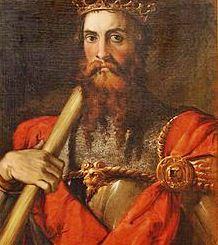
Second Siege of Rome |
year: 546545 - 546 |
| The Ostrogoths captured Rome and then withdrew | ★ ★ ★ ★ ★ |
|
enemy: Ostrogoths
|
location: Rome, Italy
|
accuracy:
●●●●●
|
|
battle type: City Capture |
war: Gothic War in Italy |
modern country:
Italy |
| ▼ The Byzantines(emperor: Justinian I) | ▼ The Enemies | |
| Commander: | General Belisarius | King Totila |
| Forces: | ||
| Losses: |
| Background story: |
| The campaign for the recapture of Italy by the Byzantines began in 535. In 536, Belisarius entered Rome, where he was besieged for over a year by the Ostrogoths. The failure of the Ostrogoths in Rome and the reinforcements sent by Justinian contributed to the occupation of much of Italy in the next years. The successes continued until 540, when king of the Ostrogoths became Totila, who, taking advantage of the departure of Belisarius, managed to reverse the situation and recapture most of the lands in Northern Italy. |
The Battle: |
 Portrait of Totila by Francesco Salviati The defenders of Rome were led by the magister militum Bessas, whose speculative practices accelerated the emergence of famine. Bessas had a stock of grain but would only sell it to the civilian population at highly inflated prices. He also forbade civilians to leave the city. Procopius describes the famine during the siege, in which the average Romans, who were not rich enough to buy grain from the military, were reduced to eating bran, nettles, dogs, mice and finally “each other's dung”. Some committed suicide. Finally, Bessas allowed the Romans to leave from the city but many perished on the journey, since they were already enfeebled by famine, while many were killed on the road by the enemy. Pope Vigilius, who had escaped to the safety of Syracuse, sent a fleet of grain ships to help the situation, but Totila's fleet intercepted them near the mouth of the Tiber. In the meantime, by 544, Belisarius had returned to Italy, but he was not able to deal effectively with Totilas yet, having at his disposal a small military force of inexperienced soldiers. He had encamped at Portus, a port on the northern estuary of the Tiber, near Rome, and although he had defeated the Ostrogoths in a skirmish, he was unable to decisively help the besieged (or perhaps he just didn’t want to help Bessas). On December 17, 546, after the city's defenses were completely weakened, a group climbed the walls and opened the gates for the Ostrogoths to enter. The Ostrogoths advanced very slowly and carefully into the city and the defenders found time to leave it. Only 26 soldiers and 60 civilians were killed during the capture. Rome was looted, but Totila, who in other cases destroyed the fortifications of each city he occupied, stopped the demolition of the walls and gates of Rome and did not carry out his threat to turn the city into a sheep pasture. |
Aftermath: |
| Shortly afterwards, Totila left Rome, unable to keep his forces there, because he had to continue the war in the rest of Italy.
After his departure, Belisarius entered the city with his small army and recaptured it. Rome was besieged again by Totila in 549 and after a short siege it was recaptured and then he carried out extensive repairs and reconstruction. A few years later, however, the Ostrogothic kingdom was finally overthrown by Narses. |
|
|
